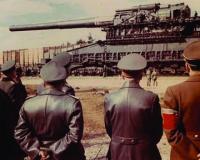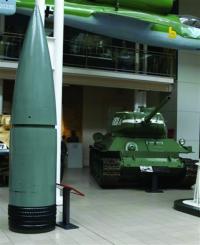Written By: Sam Ghaleb Ridgecrest, Calif.

Adolf Hitler (center of group) and "Gustav"

Adolf Hitler (second from right) and "Gustav"

The shell fired by the Gustav next to the 26.5 ton Soviet T-34 tank.
In the 1930s France embarked on a national defense plan to build the Maginot Line, which consisted of a series of fortifications that stretched from Belgium to the Swiss border. These fortifications were the heaviest in the world. No other nation ever attempted to build such a complex and well protected system of fortifications for the defense of its border. The Maginot Line was constructed to protect France from potential German attack across its border. When Hitler came to power in 1933, he started to rearm Germany and build up its armed forces to an unprecedented level to deal with any future conflict in the east and the west. One of the challenges that faced the German High Command (OKH) at the time was how to deal with the massive fortifications of the Maginot Line.
In 1934 the German High Command, under directions from Hitler, commissioned the giant armament factories of Krupp to design a gun that was capable of destroying the forts of the French Maginot Line which were then nearing completion. To design such a gun, Dr. Erich Müller, the chief designer of heavy guns at Krupp, calculated that the task would require a weapon with a caliber of around 80cm (31.5 inch), firing a projectile weighing 7 tons, from a barrel 100 feet long. The gun fully assembled weighed 1,329 tons, the size of a World War II destroyer. It could only be moved on twin sets of railway tracks. This gun stood at two and a half stories high and had a range of 24 miles for its seven ton projectile.
In comparison, the biggest U.S. guns in World War II were those carried on the Iowa class battleships. Those guns were 16 inch in caliber, and each barrel weighed 120 tons, and fired a 2700 pound armor piercing shell to a range of 24 miles. A fully operational turret on an Iowa class battleship weighed 1,700 tons and had three barrels.
Nothing further happened until March 1936, when Hitler visited the Krupp headquarters at Essen, during which he enquired into the giant guns' feasibility. No definite commitment was given by Hitler, but design work began on an 80 cm model. The resulting plans were completed in early 1937 and approved. Fabrication of the first gun started in the summer of 1937. However, producing such a large weapon proved difficult and it became apparent that the original completion date of spring 1940 would not to be met.
Three guns were ordered in 1939. Alfred Krupp, head of the giant armament factories, personally hosted Hitler at the Hugenwald Proving Ground during formal acceptance trials of the Gustav Gun in the spring of 1941. In keeping with company tradition, Krupp refrained from charging for the first gun - 7 million Deutsch Marks were charged for the second gun, named Dora after the chief engineer’s wife. The first was named for Alfred Krupp’s father, Gustav, the titular head of the Krupp empire.
The German blitzkrieg, in the west, in the spring of 1940, resulted in the fall of France in June of that year without the need to use the Gustav Gun. The plan to conquer the West was based on outflanking the Maginot Line by attacking the Low Lands (Belgium and Holland). The gun was never fired at the forts of the Maginot Line, so new targets were sought. Plans to use Gustav against the British fortress of Gibraltar were scrapped after General Franco refused permission to fire the gun from Spanish soil.
The next plan for the gun was developed in 1942 to help the German and Romanian armies which had been bogged down in the Crimea Peninsula of Soviet Russia for ten months. The plan called for the gun to be sent there to help conquer the Soviet forces in Sevastopol. Sevastopol was considered by many to be the most heavily defended city in the world.
In February 1942, Heavy Artillery Unit (E) 672 was reorganized and went on the march, and "Schwerer Gustav" ‘Big Gustav’ as it was called by the Germans, began its long ride to the Crimea. The train carrying the gun was of 25 cars, and had a total length of 1 mile. The gun reached the Perekop Isthmus, connecting the Peninsula to the Soviet mainland in early March 1942, where it was held until early April. To get the gun closer to its target, a special railway spur line was built to the Simferopol-Sevastopol railway 10 miles north of the target.
Gustav eventually went to war during the siege of Sevastopol in the spring of 1942. The whole process of assembling Gustav's 1,329 tons took about three weeks and a force of 1,420 men commanded by a Major-General. With such a high ranking officer in charge, the gun was considered to be equivalent to a division. When fully assembled, the gun would be 141 feet long, 23 feet wide, and the axis of the barrel some 25 feet above the track. A special four-track section had to be laid to put the gun into action; on the inner tracks the gun bogies were assembled and linked together, and on the outer pair ran a gantry crane for assembling the rest of the weapon.
In April 1942, the Gustav Gun went into action against the heavily fortified port city of Sevastopol in the Soviet Union. Under fire from Gustav and other heavy artillery, Forts Stalin, Lenin and Maxim Gorki crumbled and fell. One of the gun’s 7-ton concrete-piercing shells is reported to have penetrated 100 feet of earth before detonating inside an underground ammunition store near Severnaya Bay. A near miss capsized a large ship in the harbor. Gustav fired 48 rounds during the siege wearing out the original barrel in the process.
The second gun, Dora, was set up 9 miles west of Stalingrad in mid-August. It was ready to fire on September 13th. However, it was quickly withdrawn when Soviet encirclement threatened the city. When the Germans began their long retreat they took "Dora" with them.
After Sevastopol, Gustav disappeared from the lime-light. It was sent to the besieged city of Leningrad, but the Soviets had other ideas and had pushed the German army back before the Gustav could be made ready. Its only other recorded appearance was outside Warsaw in the summer of 1944 when some 30 shells were fired into the city during the abortive popular uprising. After that Gustav vanished. Numerous reports of its discovery in pieces, its scrapping, its capture or abandonment have been suggested but none of them stand up to very close examination. Spare barrels and ammunition were found, but the gun itself was never seen again, despite some reports that it was found wrecked on its special train by a US army unit in Bavaria at the end of the war. It seems likely that it was simply scrapped some time during late 1944. Dora, the second gun was blown up by German engineers in April 1945 near Oberlichtnau, Germany, to avoid capture by the Red Army. The incomplete third gun was scrapped at the factory by the British Army when they captured Essen.
Gustav had cost 10 million Marks. The price of the ammunition is unknown. The price of maintaining and operating the gun was enormous by every standard, but its only achievement seems to have been the demolition of a few Soviet and Polish defenses and one ammunition dump, which was hardly a great achievement for a weapon that had cost so much in effort and money. For propaganda, or for boosting morale, or for frightening an unsophisticated enemy, Gustav, and the other super-guns, may have had their uses, but as a cost effective weapon of war it was nevertheless a non-starter.
NEXT WEEK: THE GERMAN FÜRHER MEETS THE SPANISH CAUDILLO AND THE FRENCH MARSHAL
«Go back to the previous page.


